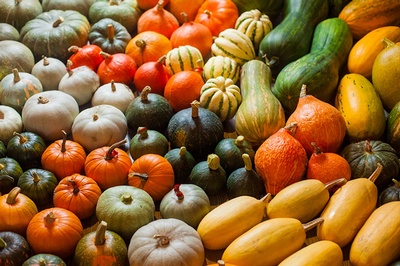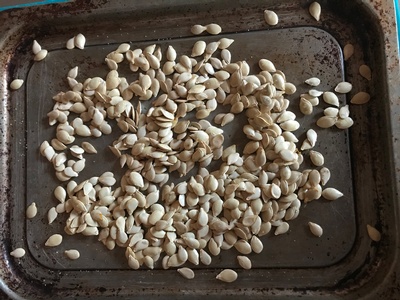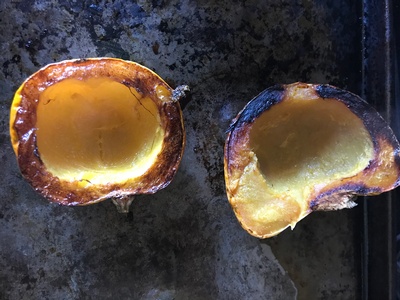Thank you to Nourishing Literacy (NL) team member Carolyn for writing this blog post! In addition to sharing her experience and findings, Carolyn has included some of the activities and approaches that we use in NL. The Nourishing Literacy team enjoys providing interactive food information, ideas that spark curiosity, and that are inclusive to all ages and skills.
Squash can be made into savory or sweet dishes and can take the form of many different textures when prepared. What kinds of squash have you enjoyed or might you like to taste?
Sensational Squash
As summer fades and a chill enters the air, I begin practicing rituals of warmth and comfort that carry me through autumn and winter. Often at the top of my list is to make a giant pot of butternut squash soup. A popular winter squash variant, its vibrant orange color, creamy texture, mildly sweet flavor, and heartiness soothe me. As the days grow colder, I delight in the varieties that are available: hubbard, acorn, buttercup, kabocha, delicata, spaghetti, carnival, calabaza... Sporting quirky curves, funny bumps, irregular shapes, stripes, and gradations of color that range from orange to yellow to green and beyond, winter squash are one of nature’s great gifts: full-blown characters in the farm fields and on the fruit stand. Just seeing one on my kitchen counter brings me joy.
Squash Across Cultures
Versatile, nutrient-rich, and long-lasting, winter squash are prized around the world with good reason. All squash belong to the Cucurbitaceae (gourd) family, and edible squash can be divided between the hard-skinned winter and the soft-skinned summer varieties (such as zucchini). Native to the Americas, squash is technically a fruit though generally consumed as a vegetable, in dishes ranging from soups and stews to porridge, pancakes, pies, fritters, pasta, and more. Their wide adaptability is matched by a myriad of health benefits—winter squash boast the antioxidant and anti-inflammatory power of beta carotene, as well as vitamin C, several B vitamins, potassium, fiber, and omega-3 fatty acids. The winter squash harvest extends from early fall through early winter, and many hard-skinned squash will keep for months if stored in a cool, dark place.
The dense texture of winter squash makes it ideal for soups, stews, purees, and dumplings. In North African culture, squash is often combined with chickpeas and cooked in clay pot tagines. A common Zimbabwean preparation combines mashed squash puree with peanut butter. Vietnamese Canh Bi Do Thit soup features chunks of squash with pork, cooked in a spicy broth. Japanese dishes incorporating squash include breaded and fried tempura, boiled kabocha with sesame sauce, and rice balls filled with steamed squash and yam.
Pumpkin and squash pies can be popular finales to Thanksgiving celebrations, but there are countless other ways to turn squash into a dessert. An Egyptian crustless version of squash pie is filled with nuts and raisins and topped with a béchamel or creamy milk sauce. Korean hobakjuk is a sweet squash porridge served for breakfast and dinner alike. Day of the Dead celebrations in Mexican communities might feature candied calabaza, squash steamed with spices like cinnamon and clove, drizzled with syrup, and topped with sweetened condensed milk.
Check out the following article for more information about different cultural preparations of winter squash around the world. Many of these dishes can be found in the kitchens and restaurants of Philadelphia’s culturally rich communities.
Serving up Squash: Recipe Ideas
Winter squash may be endlessly adaptable, but their tough outer shell can be hard to cut. Two ideas include carefully piercing the skin in a few spots with a knife and placing in the microwave for 5 minutes, or cooking the squash whole in the oven on a baking sheet at 400 degrees for about 10 minutes. In both cases, allow the squash to cool enough to handle before cutting.
Before cooking your squash, first try salvaging its seeds for a snappy, nutritious snack! Cut your squash in half lengthwise, then gently scoop the seeds from the flesh, using a spoon and your fingers to separate them into a colander or bowl. Putting the unseparated seeds in a small bowl of water is another way to remove them from the attached flesh. Place the cleaned seeds on a baking sheet with a little oil and seasoning and roast at 350 degrees for 15-20 minutes. Once they start to brown or pop, they’re ready.
Among the many versions of butternut soup I’ve tried over the years, the Joy of Cooking recipe, which relies on first roasting the squash, is a favorite. It combines roasted squash, leeks (or onion), ginger, butter, and water or broth. Pureed with a blender or food processor, this is a wonderfully creamy non-dairy soup.
Cubed and seasoned, roasted squash is great to eat on its own or mixed with something else. Soften first by warming (see above) to remove the skin or use a peeler to remove the skin from raw squash, and cut into cubes. Tahini, za’atar, and red onion in Yotam Ottolenghi’s recipe from Jerusalem: A Cookbook transforms butternut squash into an elegant Middle Eastern feast. Tossing hearty greens such as kale with roasted squash cubes is a nice way to warm up a winter salad. Top with nuts, cheese, and dried or fresh fruit for added color and texture.
Some winter squash varieties, like delicata, have skin soft enough to eat. Halve lengthwise, cut crosswise into half-moons, roast, and try tossing with oil and sugar for a side dish that feels like a treat.
Making Squash Pancakes From Scratch
All this squash talk inspired me to finally test a recipe I’d found on the internet and bookmarked years ago: squash pancakes. From two small carnival squashes, I had enough mashed pulp to double the recipe, yielding two 12-pancake dinners for my family of three. We ate them all in each sitting, and fast! Once you roast the squash, the batter comes together in a pinch. If you’re able to find sage, crisping it in brown butter makes this dish really delicious. We had maple syrup in the fridge and we did not regret drizzling that on top too.
The full recipe can be found on the Smitten Kitchen website and a slightly modified version is below. Both physical and ebook versions of The Smitten Kitchen Cookbook and Smitten Kitchen Everyday: Triumphant and Unfussy New Favorites can be checked out from our catalog with your library card.
Ingredients:
- 1 cup pre-cooked or canned mashed squash
- ⅓ cup yogurt, sour cream, milk, or water
- 2 eggs
- ½ cup grated cheese
- ¾ teaspoon salt
- ¼ teaspoon black pepper
- 1 teaspoon baking powder
- 1 cup flour
- Butter or oil for frying pan
Directions:
- Stir together all ingredients, except the butter or oil for the pan.
- Heat pan to a medium temperature and add a small amount of butter or oil for cooking.
- Place spoonfuls of batter into the pan (with each pancake equalling about ¼ cup of batter). Flatten the spoonfuls of batter in the pan so they will cook evenly.
- Turn heat down to medium-low.
- Cook for 3 minutes or until browned underneath. Flip and cook for another 3 to 4 minutes or until the pancake is golden brown on the other side.
Free Library Resources
If you feel funny about your fondness for squash, don’t fret—you’re in good company. Children’s author Pat Zietlow Miller puts squash front and center in Sophie’s Squash, the story of a young girl who falls in love with a butternut squash, names it Bernice, and brings it everywhere. As time passes and Bernice begins to change, Sophie and readers get a novel introduction to the cycle of life. Available for physical checkout and as an ebook with your Free Library card.
Carlos and the Squash Plant / Carlos y la Planta de Calabaza is another children’s book that centers on a young character’s love for squash. In the mountains of New Mexico, Carlos and his family tend to their farm, where they grow fruits and vegetables ranging from watermelon and corn to squash. This bilingual (Spanish-English) book introduces readers to the Hispanic culture of the southwest U.S. and includes a recipe for the spicy summer squash casserole calabacitas.
The Free Library is a virtual bounty of physical and digital resources on cooking and gardening, with numerous titles dedicated to squash. Amy Goldman's The Compleat Squash: A Passionate Growers Guide to Pumpkins, Squashes and Gourds is available for physical checkout and dives deep into this food family, profiling their personalities and backstories alongside 150 "portraits" by award-winning photographer Victor Schrager. Whether your squash curiosity veers more academic or earthly, you’re in good hands with Goldman, who complements these gourd stories with plenty of tips on growing, harvesting, and seed saving, as well as a fair share of recipes.
Looking to be cooking? Lou Pappas Seibert will get you thinking outside the squash with the recipes in A Harvest of Pumpkins and Squash: Seasonal Recipes. From muffins and breads to flan and cheesecake, soufflés, frittatas, bisque, and more, the biggest challenge this book presents—aside from some ingredients that might be less common on supermarket shelves—is deciding what to try first. Available for digital download through Hoopla with your library card.
Maricel Presilla’s 900-page Gran Cocina Latina is a magnum opus on the food of Latin America and the 2013 James Beard Foundation Cookbook of the Year. While the recipes range far and wide, there is a chapter on squashes, corn, quinoa, and beans. Presilla combines a Ph.D. in history with 30 years of travel and professional cooking to reimagine summer and winter squash in dishes like "Peruvian Warm Purple Potato and Squash Salad with Olive Oil and Paprika Dressing", "Summer Squash in Tomato Broth with Almond", "Sesame and Chile de Arbol Sauce", and "Squash Bread Pudding with Prunes and Pisco".
Squash the Sport!
Did you know that squash is also a sport? Any search through the Free Library catalog will yield titles on this racket and ball game that hails from early 1800s England and is now played around the world. Philadelphia has a place in squash history as the site of the first national squash association. If you wander beyond the edible in your search for squash, you might enjoy A Girl Called Genghis Khan, the inspiring true story of Maria Toorpakai Wazir, an international squash star from Pakistan.
Stories from Squash: Writing Activity
Optional Materials:
- Paper and writing utensil
- Phone or other recording device
Following the theme of Sophie’s Squash, this activity is an opportunity to practice personification—the art of transforming a thing or an idea into a person or a character with human attributes. First, find a squash that speaks to you. Notice its color, shape, texture, size, and weight. Take a few moments to jot down words, images, make a voice recording, or simply think about these characteristics. Next, imagine how your squash might behave if it came to life. What would its name be? What would its voice sound like? Keep going, trying to come up with as many human attributes as you can, until your squash turns from fruit to something more: a sentient being. You can write these ideas down, turn them into pictures, make an audio recording, or hold them in your mind. Once you’ve developed your central squash, maybe you’ll turn it into a squash story, develop a series of squash cartoons or images, or record a squash song. The opportunities are limitless when you tap into the power of your imagination.
Squash in the City: Community Resources
Winter squash are on full display across the city, wherever you find fruits and vegetables. Want to search for squash beyond your usual shopping stops?
Check out the Food Trust’s Guide to Farmer’s Markets in Philadelphia for locations and dates of operation.
The Pennsylvania Horticultural Society maintains a list of community gardens, including an option to search and find by location.
Interested in growing your own squash? A great site for starter plants and seeds is Greensgrow, an urban farm and garden center with locations in the Riverwards and West Philadelphia. Founded in March 2020, the Cooperative Gardens Commission is a food sovereignty collective with groups operating across the country, including a seed distribution hub in Philadelphia. Visit their website to apply for free seeds in 2021; priority given to BIPOC applicants and communities.
Philadelphians can apply for raised beds, starter plants, and soil through Sankofa Community Farm at Bartram’s Garden; note that they prioritize residents who live near Bartram’s Garden.
Have further questions? Pennsylvania State University’s Master Gardener Program operates a hotline where the general public can call with any and all gardening queries.
Whether you’d like to cook, eat, read, or write, perhaps the squash can be a source of warmth and inspiration during the cold months of winter ahead.
______________________________________________________________________________________________________________________________________________
Nourishing Literacy offers food, literacy, wellness, and life skills activities and programs to youth and intergenerational community members. To learn more about the Culinary Literacy Center, please visit our website or connect with us through Instagram and Facebook.
Have a question for Free Library staff? Please submit it to our Ask a Librarian page and receive a response within two business days.



